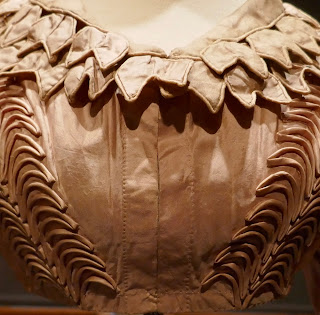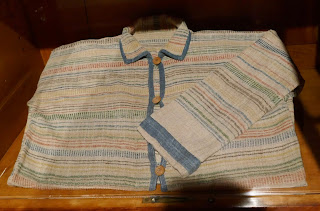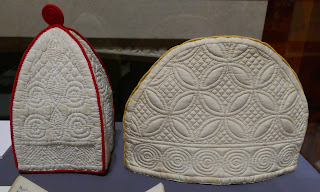"An extraordinary late Victorian mansion built by William Waldorf Astor on the Embankment. The building was originally designed for use as Astor’s estate office by one of the foremost neo-Gothic architects of the late nineteenth-century, John Loughborough Pearson. Astor had emigrated to England in 1891 as, arguably, the richest man in the world, and no expense was spared when work began on Two Temple Place in 1892. In addition to the extraordinary, opulent interior, when it was finished in 1895, Two Temple Place contained the largest strong room in Europe as well as two other enormous fortified safes."
It is indeed a v nice building but I wasn't there to look at it, but to see an exhibition called Unbound, which was billed as being about "Visionary women collecting textiles". When I got there, I realised that as usual these days the curators had decided that the exhibition, (a celebration, naturally, ugh) wasn't really about cloth but about politics - in this case mainly the fact that the women highlighted "defied the 'traditional' concept of collecting, an activity still more often associated with men, and forged the way for textiles as crucial documents of social history as well as works of art in their own right." One wall panel explained that because textiles are part of everyday life, their "familiarity makes them a powerful form of material culture, particularly in relation to individual and cultural identity". Can you hear the effort with which identity has been levered into the arena? "Community-based response to cultural diversity, wellbeing and social activism" also got shoehorned in somehow and supposedly those three themes were also explored by the earliest collectors featured in Unbound.
What a load of total nonsense. Some of what the curators had to say wasn't even grammatical: "Contextual understanding, cultural awareness and contemporary relevance have each come to play significant factors in curatorial decisions" they announced, but I cannot make any sense of the phrase "come to play significant factors", and I think that the reason I can't is because it is meaningless; a factor cannot be played.
Never mind. The women the curators chose to centre their exhibition around turned out to be very difficult to box up into the contemporary obsession with identity.
First was Olive Matthews (1887-1979) who liked collecting things and after an "initial interest in antique furniture was discouraged due to lack of space" - (this conjures in my mind amusing scenarios where her family, edging around pile upon pile of chairs, tables, cupboards et cetera, hesitantly suggest that she might try postage stamps) - shifted her attention to clothes. She ended up with 3,000 things and donated the collection to Chertsey museum in 1969, leaving "little information on the rationale for her collecting". I speculate that this might be because there wasn't one, because it was, more than likely, an entirely irrational activity more akin to an obsession.
Edith Durham was next up. She was 37 in 1900 when she went to Montenegro, having spent years looking after her invalid mother and becoming quite worn down. Until the outbreak of World War One, she then went back to the Balkans every year and, during what she called the 'grey months' back in London, she studied Serbo-Croat and lobbied on behalf of the Balkans, most particularly Albania, where she is apparently still celebrated, although I don't remember any sign of her when I was there in 1985 and 1986.
If I'd been one of the curators, I'd have seen a perfect opportunity in Edith Durham's life to highlight the unfairness of life for single women before feminism and to whinge about that for a bit. Somehow though they let that dull boat set out to sea without them. I'm not complaining.
They could also have gone on about exploitation and cultural appropriation, given that Durham brought so many lovely pieces of embroidery back from her travels, but maybe their hearts were only half in their identity-infused enterprise. Indeed it's possible that they felt that right at the start of the exhibition they were obliged to give a nod to it and then they could proceed, free of its constraints. Perhaps the whole world is engaged in a kind of cultural identity genuflecting, and no one is brave enough to say, "Actually, let's just not bother with it at all."
After Edith Durham came Louisa Pesel, who studied design and embroidery at the Royal College of Art, taught by a contemporary of William Morris. She was fascinated by stitch techniques and gifted at engaging people in her preoccupations. She was a designer then director at the Royal Hellenic School of Needlework and Lace in Athens (1903-7) and eventually was part of the Winchester Cathedral Broderers. She believed in historical research, studying stitch techniques closely and staying near the original wherever possible. She was very active in the Bradford Khaki Handicrafts Club, where she taught shellshocked men embroidery, (the results suggest this was not a Sir Arthur Strebe-Greebling-type enterprise, however it may sound).
It seems to me that Pesel and her beliefs could have formed the heart of a much more satisfactory exhibition about the arts and crafts movement and about craft and its beneficial role in the lives of individuals - not only practitioners gain satisfaction from skilled craftsmanship but also the possessors of beautifully made work; living with something a fellow human has fashioned with skill and care is a delight and one of the reasons I believe buildings made before industrial techniques came in are always more refreshing to their users, full as they are with what John Updike referred to as "the quiet outpouring of refined details."
Upstairs the curators also missed the opportunity to moan about cultural appropriation when introducing us to Muriel Rose, who in 1928 set up the Little Gallery in Ellis Street near Sloane Square, London. She sold lots of quilts and embroidery, as well as Mexican rugs and Japanese ceramics, the beast. The gallery closed on the outbreak of the Second World War and "ultimately, Rose founded a 'handling collection' of craft" which "represents the earliest effort by a government organisation [they don't tell us which one, but presumably Rose was involved with something] to bring together a 'national' craft collection, which now resides at the Crafts Studies Centre, Farnham."
Enid Marx came next. She was a leading designer and a collector of 'popular art', as well as being "an innate collector who had been fascinated with ephemeral materials such as silk ribbons since childhood." Popular art according to Marx and her friend Margaret Lambert is "the art which ordinary people have, from time immemorial, introduced into their everyday lives, sometimes making it themselves, at others imposing their tastes on the product of the craftsmen or of the machine."
Who defines 'ordinary people'?
Beyond Enid Marx, the exhibition began to fail for me, as we moved further into the twentieth century. I had come because I am inspired by skilled craftsmanship and convinced that its practice is one of the things that improves and calms the human spirit and that the loss of the respect we once had for it is part of the reason our societies are failing.
Which I suppose makes me pretty political about the subject - in which case I ought to modify my objections and say that it is not bringing politics into everything that annoys me, it is only the bringing of the hateful dead end that is identity politics in that offends me. If we don't stop making everything about identity, we will find that all the finest aspects of our civilisation will be destroyed and we will live in a primitive wasteland, without beliefs or hope.
But now to the important bit, the exhibits themselves.
The first thing that met my eye on entering was a 'Spencer' made at some point between 1815-17, from embellished silk taffeta with cotton lining. It was on loan from the Olive Matthews Collection at the Chertsey Museum.
The label on the exhibit explained that spencers were short, bodice fitting jackets that formed part of Regency 'walking dress': costume worn on outdoor occasions, when one wanted to be seen. The full outfit would include a dress, outer garment or wrap, a head covering and gloves. Until the 1820s, the spencer was often made of coloured silk. The silk provided a more structured contrast to the muslin of the dress beneath, as well as providing a little protection from cold. This spencer's cuff decorations and epaulettes are inspired by the military uniforms of soldiers fighting in the Napoleonic wars, a style popular around the time of the Battle of Waterloo in 1815.
What enthralled me about the garment was the fact that it was so detailed and yet had been sewn entirely by hand. How long did it take to make each petal round the neckline and to make and attach each of those loops? To me, it is a work of great intricacy but when it was made it may not have been unusually detailed.
I am including several pictures of details of the garment here, not because I particularly like it as a piece of clothing (I like simpler things) but because I admire the workmanship and assume that anyone reading this will be as interested as I am in the business of needlework and garment construction:
The label on the exhibit explained that spencers were short, bodice fitting jackets that formed part of Regency 'walking dress': costume worn on outdoor occasions, when one wanted to be seen. The full outfit would include a dress, outer garment or wrap, a head covering and gloves. Until the 1820s, the spencer was often made of coloured silk. The silk provided a more structured contrast to the muslin of the dress beneath, as well as providing a little protection from cold. This spencer's cuff decorations and epaulettes are inspired by the military uniforms of soldiers fighting in the Napoleonic wars, a style popular around the time of the Battle of Waterloo in 1815.
What enthralled me about the garment was the fact that it was so detailed and yet had been sewn entirely by hand. How long did it take to make each petal round the neckline and to make and attach each of those loops? To me, it is a work of great intricacy but when it was made it may not have been unusually detailed.
I am including several pictures of details of the garment here, not because I particularly like it as a piece of clothing (I like simpler things) but because I admire the workmanship and assume that anyone reading this will be as interested as I am in the business of needlework and garment construction:
Some might say that the person who made the spencer was a poor desperate soul, forced to toil over something that was unnecessary. I would argue that craftsmanship has its own rewards and that dissatisfaction with working conditions is much more prevalent in our industrial age, where speed and cheapness are the only things valued, leaving few workers the opportunity to make things beautifully, something that supplies its own satisfaction.
Here are a couple more things that Olive Matthews collected:
Here are a couple more things that Olive Matthews collected:
Turning left after the spencer in the first room of the exhibition, one came upon this magnificent garment, splendid inside its glass case.
It is a 19th century Albanian garment called a giubba. It is made of fine black cloth with braided embroidery in gold cord and, apparently, a printed cotton lining. It was on loan from Bankfield Museum, Calderdale Museums Collection. A Giubba is (or was) part of the indoor dress of women in Scutaria, Albania and could be worn over a sik shirt and full trousers. This belonged to a Catholic but similar garments were worn by both Christian and Muslim women. Edith Durham bought it in 1907. A complete circle of about one metre radius was used to make the skirt:
Very much less sumptuous but rather marvellous in their own way, here are Edith Durham's shoes, their uppers made from twine, amazingly:
She wrote of these shoes: "When newly made, the soles are soaked in oil till pliable They then mould themselves to the feet and give the fresh soles a good grip on rocks. The soles of this pair are worn through as I tramped many miles in them." Behind them is a towel that was woven in Scutari; Edith Durham bought it there and used it when travelling.
Edith Durham had originally trained as an artist and she made these sketches, including the final one, of a loom, about which she tells an amusing story in the accompanying typed letter:
Now we come to the part of the exhibition closest to my heart, the bit that covers the activities of Louise Pesel and the Bradford Khaki Handicrafts Club, which was established in 1917 to provide occupational therapy and employment for men returning from the First World War. Pesel taught ex-soldiers to embroider as a therapeutic distraction. She designed and helped them to embroider a cross-stitch altar frontal for the Abram Peel Hospital Chapel. The hospital was a specialist neurological hospital treating wounded soldiers and it was there that the club was set up in 1914, in partnership with the Bradford Women's Police Patrols, which had been formed to help women mill workers return home safely at night. Nineteen thousand soldiers attended various Bradford hospitals at that time, and women volunteers met hospital trains and introduced soldiers to the Club, which provided support, food, recreation and therapy.
 |
| Pages from Pesel's sewing guide, including stitch patterns with samples. |
"Go and see what Miss Pesel is doing at the Handicraft Club, a lot of the improvement in the soldiers' condition is due to her", the head of the Abram Peel Hospital wrote to the visiting Medical Board.
Upstairs the rather adorable publicity material for Muriel Rose's Little Gallery was on display, designed by Alan "Sam" Smith:

together with Muriel Rose's Jacket, made between 1920 and 1924 from Eri silk with wooden buttons. The cloth was woven by Ethel Mairet, who pioneered modern weaving in Britain. She made the Little Gallery her depot and attended it in person one day each month to meet customers. The jacket is one illustration of the friendship between Rose and the craftspeople she supported. It is made from a length of handwoven silk Mairet exhibited at the Paris International Exhibition of Modern Decorative and Industrial Arts in 1925. Mairet's brother, Frederick Partridge, made the buttons:
I'm puzzled that this material was so highly regarded as, in the 1970s, there used to be a weaving course run in Harrogate; I visited when I worked for the Crafts Council's magazine Crafts and I thought the handwoven lengths being made there were infinitely finer than this example. One has a slight sense that austerity was not just a necessity but a style for a short time in the early twentieth century.
Muriel Rose commissioned these beautiful tea cosies under the British Government's initiative, the Rural Industries Bureau, a scheme set up to support the production of rural crafts, which were experiencing a state of acute depression between the wars. The Little Gallery commissioned and sold examples of quilting made by women from deprived regions of South Wales and Northern England, which sounds a tremendous idea. Rose said that many of the patterns "show their derivation from Tudor times and the 17th century."
The woven lengths on display, made by a founder of the Guild of Weavers, Spinners and Dyers, did not fill my heart with joy, (indeed they brought to mind something CS Lewis wrote about the difference between good work and good works and the items often produced to be sold at church bazaars illustrating how the latter did not always imply the former). However, I was intrigued to see a bowl by Lucy Rie, who I met once, after Hans Coper died - I had to go to her house to fetch some of his work (an example of which is visible on the right of the picture below) to take to be photographed for a valedictory feature. Believe it or not, I chose to conduct this task by bicycle, with the precious objects rattling about in my front basket. There were no breakages - not so much as a tiny chip. Thank you, thou in heaven, I am sorry it took me so long to write you a letter of gratitude but I most certainly do now. Why was I such a nincompoop?
I'd run out of steam by the time I reached Edith Marx's textile designs - and, anyway, although I like her book covers, I've never liked the colour palette she chose when designing fabric.
There was one delightful thing still to be seen in the exhibition though - this late 19th century unbleached cotton Kantha or summer quilt from West Bengal, with its countless patient stitches and depictions of elephants, horses and other creatures:





































No comments:
Post a Comment